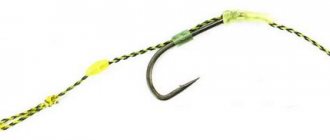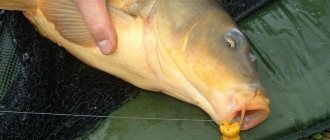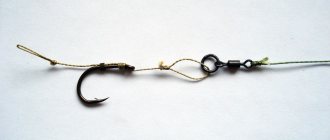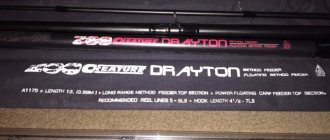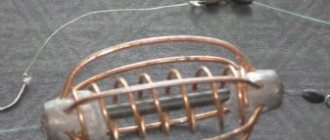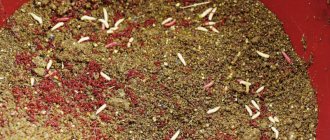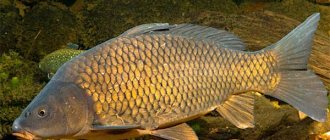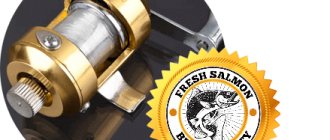There are two ways to catch carp - using bottom or float gear. The most common type of fishing is using a float rod. Its use allows you to catch fish in ponds (or in any other aquatic environment) with a large layer of silt, during the hot summer season, and during the spawning period of carp. The advantages are that fishing does not require special physical effort and with the help of this tool you can get a catch that is quite decent for beginners.
This gear has several varieties:
- Flywheel - the length of the rod is 4-7 meters, quite light, the reel used is the simplest. You can throw the equipment into the water with one movement of your hand.
- Match - length 4-6 meters. This fishing rod is equipped with a spinning reel and is used for casting over long distances. The basis of the equipment is a heavy sliding float.
- Plug tackle – has plugs that are fully retractable. The equipment is delivered directly to the fishing spot. In order to catch carp weighing 1-2 kg, the choice of a specific fishing rod does not matter much. Any will do. If you want to try your luck and try to catch a trophy carp, then you should use match gear with a reel.
Catching carp with a float rod: rod equipment, bait and bait
It's no secret that currently the most popular tackle is the float.
Although over the past few years, interest in such gear as feeder rods has increased among fishermen. This indicates the fascination of this fishing method. But if you are planning to go fishing for carp, you should carefully choose your gear. It must be borne in mind that this is a rather strong predator. You will have to fight even with a small specimen when playing. There are a huge number of carp spinning rods today. When choosing a fishing rod, pay attention to its “power”. Since this fish is quite strong, a weak rod simply cannot cope with such an opponent. As a rule, serious telescopes are used. Equipped with a spinning reel and strong rings. In addition to power, you should also pay attention to the softness of the rod. Thanks to this quality, you will be able to absorb blows or jerks of the carp when fishing.
The reel must have friction brakes, and the gear ratio must not be higher than 5:1. In this case, the location of the clutch (front or rear) does not matter; you should select it primarily based on convenience or habit. It is better to choose a volumetric reel spool. This choice will make itself felt when you come across a large or very “live”, mobile carp. It’s difficult to concentrate on fishing when all your thoughts are about whether there’s enough line on the spool.
The fishing line must also be specific. Carp is very careful; it is not for nothing that many fishermen call it a fox. Therefore, you should choose the optimal type - it should be as thin as possible, and at the same time have high strength. If you take a thick fishing line, it will simply scare away the predator. The most suitable diameter is 0.28...0.3 millimeters. In this case, it is advisable to purchase it from a reputable manufacturer to be sure of the quality. This rule applies to all gear.
It is worth saying that braid is not suitable. This is due to the fact that it simply does not have sufficient stretchability. And this quality is valued when using float gear. The hook should be sharp, have a small shank, strong and thick enough. Having a small fore-end, it easily hides in the bait. If it is thin (made of thin wire), it will simply cut the fish’s lip. The most optimal hook number for carp is from 5 to 7.
Float rod equipment for carp
When choosing, you should proceed from the natural timidity and caution of this fish. Therefore, the use of large and bright floats is contraindicated. The priority is weight from 1-3 grams, calm colors. The shape is controversial, but there are parameters on which anglers agree, these are: the lower part should be as short as possible (short keel), teardrop shape (slightly round and elongated body), thin antenna.
Don't forget about the fishing conditions. When casting long distances, you simply need a heavier float; for a short distance, a light one will do the job. In shallow water, carp are extremely suspicious and cautious, taking the bait very carefully. As soon as he feels resistance, he will immediately spit out the tackle. To summarize: in shallow water, use a float weighing up to 2 grams; when fishing at depth, it is better to take 3-4 grams.
It’s better not to skimp on hooks. It’s up to everyone which company to buy, but the important components are: sharpness, size 6-12, self-cutting design. It should not have a wide hook width (the distance between the forearm and the tip). If the material used in production is not of sufficient quality, and the carp is large, this can lead to unbending and, as a consequence, to the escape of the fish.
Correct loading will increase the chances of catching a trophy. This will determine how well you can observe the bite, and how strongly the float will react to gusts of wind.
We equip a float rod for carp fishing
Catching carp with a float rod is an interesting, but difficult activity. After all, if you decide to fish for small fish, then there is no need for tricks - it can be caught well with the same tackle and bait as crucian carp, often even mixed with it. It’s a different matter if you want to catch an adult, trophy specimen. Here it is better to seriously prepare, but even this does not guarantee a good catch, because adult carp are a capricious fish and almost always cautious. Compliance with certain rules increases the chances of a good catch, and we will try to help you with this. So, what do you need to successfully catch carp with a float rod? Let us consider the aspects of this issue in more detail.
Privada, groundbait and flavorings
Privada
Catching carp with a float rod will be much more effective if we initially used bait. That is, for several days, we visited the pond and fed the carp. Moreover, they did this at the same time. As a spice, you can use: corn, steamed or young peas, dough balls, chopped boiled potatoes, pasta, various boiled legumes, rye, wheat, bread crusts, all kinds of boiled porridges.
As a rule, the bait consists of 5-8 components, and they must be large in order to cut off the fines. Various aromas are often added to the bait. If you don’t want to spend expensive aromas on spices, use finely chopped dill or mint, hemp seeds, garlic, cinnamon, and vanilla.
In winter, as a bait, it is better to use soil mixed with a worm, oparish or bloodworms.
Lure
A mixture of store-bought bait and additional homemade ingredients is quite effective. It is recommended to purchase carp bait, for example Sensas 3000 Match Carp, Traper Big Carp, DUNAEV Premium Carp Carp, MINENKO PMbaits CARP, Richworth carp XL , as well as all season carp . Choose based on your budget and size of fish. It’s not worth spending expensive bait on small carp.
So, take a basin or bucket and pour it in:
- 1.5-2 kg of store-bought bait;
- Hercules 300-500 grams;
- Boiled millet, you need to add it until it cools down and becomes sticky (500-1000 grams, the weight that the millet had before we boiled it);
- 1-2 cans canned sweet corn;
- In spring and autumn, bloodworms should be added to the bait.
Add the ingredients one at a time, thoroughly mixing the bait after each addition. This amount is enough for 5-6 hours of active fishing.
Flavors
Effective carp flavors are: honey, mint, dill, strawberry, tutti-frutti, pineapple, peach, banana, vanilla caramel, fried and finely ground peanuts.
Where and when do you catch carp on a float rod?
You can fish all summer and part of autumn. Carp loves heated, warm water, so if spring and early summer were cold, it’s worth waiting. The fisherman is forced to catch carp with a float either by the heavily silted bottom of the reservoir (in this case, the feeder, bottom tackle falls into deep silt), or by the interest in this particular method of fishing, because according to many amateur fishermen, catching carp with a fishing rod is a more exciting process than for bottom gear.
Usually large fish stay at depth during the day and only after sunset come closer to the shore. This is taken into account when choosing gear and feeding.
About equipping a float rod for carp
To properly assemble a fishing rod for carp fishing, the rod is selected depending on the fishing location and casting distance. For coastal fishing, a regular fly rod is suitable; for longer casting, a match or plug rod is preferable.
To catch carp over 2-3 kilograms, experienced fishermen advise using match rods, durable, with an elastic top and mandatory guide rings.
The rings are needed so that the load of large fish is distributed evenly on the rod. When fishing from the shore, the length of the fishing rod should be no more than 7 meters, otherwise it will be inconvenient to land the fish. To catch carp in the summer from a boat, a rod 5 meters long is sufficient.
Reel and line
It is better to use a small, inertia-free reel with a sensitive friction brake, because equipment with a friction brake will reduce the pressure on the line when fishing.
Because of its visibility, it is impossible to use a thick fishing line to catch this cautious fish. The same applies to braid, so it is better to use high-quality, well-stretching fishing lines or monofilament with a diameter of no more than 0.35. A little trick when fishing for carp - in addition to the main line, use a leash made of low-visibility fluorocarbon fishing line, this increases the chances of a bite.
Float, sinkers and hooks
The float tackle for carp is standard - a regular float with a carrying capacity of 3-5 grams, dim, with an informative, long antenna. You can try the option of equipping it with a sliding float, in this case the fish does not feel resistance, which has a positive effect on the bite. Which floats are best for carp fishing for you personally should be decided based on your own observations and experience.
Fly float tackle for carp
A fly rod makes it possible to catch carp both in the current and in still waters where there is a lot of aquatic vegetation and snags. During fishing, a fly rod allows us to almost completely control this process and direct the carp where we need it, preventing it from going into snags. The disadvantage of fly tackle is that we are limited in range by the length of the rod (as a rule, fishing takes place within a range of up to 15 m). Also, fly tackle does not require the presence of a reel, which means we are deprived of a friction clutch.
Rod
A carbon fiber blank is 5-7 m long; longer blanks are much heavier and have greater windage. It’s impossible to say for sure based on the action, the soft form of the slow action perfectly absorbs the jerks of the fish and at the same time it is more difficult for us to control the process of fishing and the fish can freely go into snags or reeds. Therefore, if the fishing point is free of vegetation, and a large carp is hooked, use a slow-action rod; if there are snags and algae, it is better to use a medium-action blank with a flexible and durable whip.
The fly rod does not have rings, and the fishing line is tightly attached to the tip of the rod using a connector.
Shock absorber installation
Especially for carp fishing, it is advisable to additionally equip the fly float rod with a rubber shock absorber. Read more about this fishing method here.
fishing line
Carp monofilament, thickness 0.2-0.28 mm, habits with a diameter of 0.18-0.26 mm, length 15-25 cm, when fishing in early spring the length can be increased to 50-70 cm.
Hooks
For fly float tackle for carp, hooks No. 6-14 according to the international classification are used. Sharp and durable, with a sting curved inwards.
Floats
Weight up to 5 grams, light floats weighing 1.2-1.5 grams, very sensitive, but in the presence of waves, wind and current, you may need heavier ones.
In fly fishing, drop-shaped floats are used, and in the current, a reverse drop. Also, in a standing pond you can use cigar-shaped floats.
How to catch carp with a float rod
Do I need bait?
Experienced carp fishermen claim that complementary feeding is necessary. There would be two types of bait: frequent, small portions and fractions (for example, a little corn or pearl barley), or one-time heavy feeding with large balls of a viscous mixture. One of the features of catching carp with a float rod is that the bait includes pieces of a large fraction, necessarily the one we are fishing for (for example, corn), and it is advisable to feed it in several places at once. If, during noisy fishing, the fish leaves the feeding area, we move to the reserve one.
L best attachments
The baits to be used for fishing are selected depending on the time of year and the reservoir. In spring, carp bite on animal baits (for example, worms, bloodworms, maggots), while in summer they often prefer products of plant origin (usually peas, boiled potatoes or corn). Sometimes it’s good to try a “sandwich” bait for carp, when both corn kernels and a worm are put on the hook.
If there is no bite on the traditional food for this reservoir, the carp may become interested in exotic tastes and smells. Sometimes fish can be attracted to bait that smells like strawberries or bananas, so it is advisable to try different options, or even fish with several rods.
Fishing technique with a float rod
After casting, it can take up to an hour until the bite occurs. You need to be patient, because carp fishing using a tackle with a float requires perseverance and careful attention. The bite would be both sharp and energetic, and also barely noticeable - small twitches of the float and moving to the side, it happens that the fish puts it on its side.
To catch a trophy carp after hooking, it is important not to give the line slack, and by extinguishing jerks with the help of the rod and clutch, tire the fish. When fishing, try not to let it go into the reeds or snags and always have a landing net with a long handle ready. You should take a large carp into the landing net from the head.
Conclusion
We hope that our tips will help you in such a difficult but exciting activity as catching carp with a float rod. Remember that sometimes unconventional methods also bear fruit. Therefore, do not be afraid to experiment and try new things, because experienced fishermen claim that large carp are not only very careful fish, but also curious...
Catching carp with a float rod
Catching carp with a float rod is sometimes more effective than fishing with a feeder. This is due to the fact that large carp often come close to the shore to feed.
It is much easier and more interesting to throw a light float rig by throwing in a small amount of bait. What kind of bait are we talking about, and read more about the intricacies of carp equipment below.
The easiest way to catch carp is with a fly rod (the equipment is delivered to the fishing spot with a light swing of the rod, and fishing occurs at a distance of a maximum of 1.5-2 rod lengths).
a fishing rod with rings and the possibility of equipping it with a lightweight spinning reel. The length of the rod is 4-6 meters (depending on the casting distance).
The reel is a lightweight spinning reel. It is imperative to have a sensitive friction brake; it is precisely because of this that we need such a coil. Carp is a very strong fish and when using thin equipment, even the smallest carp will easily break the fishing line at the first tug (the brake will smooth out any twitching and the tackle will remain unharmed).
Line – monofilament or braided line with a breaking load of 4 kg. If you are going to hunt for carp weighing more than 4 kg, then you can choose a thicker fishing line, but in fact, with proper adjustment of the clutch, even with such a fishing line you can pull out a carp weighing 8 kg.
Gear selection
Coil selection
For fishing with a match float rod, a mandatory element of the gear is a special carp spinning reel.
Such a coil must meet the following requirements:
- The material of the reel body is light and durable alloy;
- The shallow depth of the spool allows it to be completely filled with a large volume of thin monofilament fishing line;
- Reel size from 5000 according to Shimano classification;
- Parts of the spool drive mechanism must be made of metal or durable alloy;
- Gear ratio – for fishing you need power reels that make 4.2-4.6 turns of the spool per turn of the handle;
- At least 3-4 bearings must be installed in the handle and spool rotation mechanism;
- A prerequisite is the presence of a rear friction brake;
- Bearing in the line roller;
- Reinforced handle;
- Reliable baitrunner.
Top 3 rating of the best reels
The following models are recognized as the best reels today used in carp fishing with float tackle:
- Shimano Baitrunner XT 8000 RA;
- Daiwa Black Widow 3500-5000;
- Banax Helicon 500NF;
When fishing for carp with a Bolognese fishing rod, you can use small match spinning reels.
Line selection
When fishing, even a small carp strongly resists. This violent resistance, combined with the decent weight of the fish, dictates the need to use strong, but at the same time fairly thin and invisible fishing lines.
When fishing with match and Bolognese fishing rods, special sinking carp fishing lines with a cross-section from 0.2-0.22 to 0.3 mm are used; for a fly fishing rod - thinner ones with a cross-section of 0.18-0.2 mm.
The most popular brands of monofilament fishing line are:
- Shimano Blue Wing Line 100MT;
- Power Phantom Clear;
- Aqua PA Ultra Soft Match;
Hooks
Special hooks are used to catch carp
Their feature is:
- Strength – the carp hook should spring back, but not bend;
- Long forend;
- Very sharp, inwardly curved sting;
- Matte or black hook surface;
- The ring for the fishing line is bent inward;
The size of the hook is selected depending on the type of bait and the size of the carp living in the pond. For catching medium-sized carp, hooks Nos. 8-10 are sufficient; for large specimens, hooks Nos. 6-8 are sufficient.
Among the manufacturers most often used in carp fishing are hooks from:
- Korda;
- Fox;
- Gamakatsu;
Sinkers
The shape and weight of the sinker plays an important role in the rigging of a float rod.
- To increase sensitivity and reduce the noise produced by sinkers in contact with water, when casting, the entire load is divided into 2-3 parts.
- Lead pellets of different weights are suitable and convenient for light fly fishing rods.
- Such sinkers are secured by carefully clamping the fishing line in the slot made in them.
- For match gear, the main part of the load consists of the corresponding weight of the olive; the pellets are installed only at the leash
Float
When fishing for carp with a fly rod or Bolognese float rod, use floats with an elongated, spindle-shaped body, a long antenna, and a narrow keel. For fly tackle, take lighter and more sensitive floats with a load of up to 1.5-2 grams, while for “lapdog” take load-lifting alarms capable of holding a load of 2.5-3 grams.
Match tackle requires a special float for long casts - a waggler, which has a long thick antenna, a spindle-shaped body and its own weight in the form of washers fixed in place of the keel.
Leash
The use of a leash in float gear for carp fishing is mandatory. The length and cross-section of the fishing line depends on the type of gear used:
- When using a fly rod, the leash is made 15-20 cm long from thin fishing line with a cross-section of 0.15-0.16 mm.
- For match gear, a thicker leader line with a cross-section of up to 0.18 mm and a length of up to 40-50 cm is used.
Baits and baits
Carp have a number of priority baits. They differ depending on the time of year in which fishing takes place. In spring and summer, carp feed more on plant baits, although a hungry carp will not refuse animal bait. But in the fall, the natural food of carp is exclusively animal organisms.
In summer and spring, carp are caught on:
- sweet corn
- Polka dots
- A piece of bread (fluffed, not balled)
- Dough
- Perlovka
The presence of various fruit and sweet flavors is welcome, but in very small quantities. In hot weather it is better to avoid them altogether.
In autumn, carp are less active and are better caught on:
- Worm (both live and chopped)
- Maggot (several pieces placed through the head on the hook)
- Large bloodworm
- Larvae of various insects
Proper loading of the float is the simplest and most accurate way to achieve high sensitivity of the float equipment.
Don't know how to tie a hook to the main line or leash? Then read our article and watch the video about the strongest hook knots.
Fishing for crucian carp with a float rod is a similar guide to catching another carp species of fish.
Choosing a fishing spot
Sometimes it is difficult to predict where the carp is staying.
- Stranded by reeds or reeds
- Or came close to a steep bank
- Possibly holding on the edge near the shore
On different ponds and reservoirs, carp have different food sources, so it is necessary to experiment with finding a fishing spot. You can start by fishing near the shore, where the depth at a distance of 7-8 meters does not reach deeper than 1.5 meters. In such places, carp can come close to the shore and at the same time not be so frightened by the presence of an angler.
3) Carp fishing technique
What should you do first when arriving at a pond? Where to start carp fishing? From assembling equipment and setting up a tent? Or take another depth measurement using a marker rod?
The ideal option is to start carp fishing by carefully examining the surface of the water using binoculars and polarized (anti-glare) glasses. It is quite possible that the carp are somewhere nearby today. And the surest signal not only of his presence nearby, but also of a good (his) appetite is pop-up bubbles. Which are virtually impossible to confuse with bream “chains” or tiny crucian carp bubbles. It’s not for nothing that the British company MCF produces many of its products under the slogan “Look for bubbles!” (literally “Look for the bubbles!”).
Thus, when you spot a feeding carp, while maintaining maximum silence, quickly (but carefully) assemble your rod and try to cast the bait closer to the bubbles. Who knows, it is possible that in a few minutes you will be able to catch your very first trophy on this carp fishing trip. You can arrange your equipment and set up your tent later.
If you haven’t found any obvious signs of carp activity or this is your first time on this body of water (i.e. you haven’t previously come to it for reconnaissance), then start looking for promising fishing spots. That is, places where fish can feed or seek shelter. As for the last option, the ideal “shelters” for carp are snags, thick algae or bottom irregularities (especially under water lilies). Just remember that next to very dense vegetation, fish feel comfortable only in the morning or afternoon. Since at this time it gives off oxygen, but at night it absorbs it. And the carp becomes uncomfortable there.
Therefore, a win-win option (at any time of the day) is always snags, which not only reliably hide the fish, but also often “feed” it. As a rule, they are overgrown with small shells - one of the most favorite delicacies of wild carp. You can find the exact location of the carp’s hiding place (usually well-packed) in snags in the reservoir by “tapping” the bottom with a marker rod. That is, if you were unable to detect at least some signs of the presence of fish, then the process of catching carp should begin with this. The time you spend on a detailed study of the bottom will more than pay off in the future! And in general, it is better to fish with only one carp rod, next to the marker, at the right time and in the right place, than with five at once, thrown at random.
In what places on the pond do carps like to feed most? On ponds or lakes (with standing water) these are hills on the surface of a flat bottom or hard “islands” among soft silt. Just remember that carp will never rummage through stinking dead mud. After all, what kind of appetite can we talk about, among the stench of rotting plants and lack of oxygen? On rivers, these are coastal edges (where food is collected by the current) or bays without a current (where, most often, entire “edible fields” of pearl barley – river bivalve mollusks) are formed.
And now, when promising fishing spots have been found and baited, and the rods have been placed, you can safely arrange your fishing life. In fact, this is also a very responsible occupation, to which many do not attach much importance. But under the condition of long-term carp fishing (quite possibly even sleepless nights), proper organization of the camp will allow you not only to maintain strength, but also to get a lot of pleasure from the fishing process, even on the second or third day. You should be comfortable and as convenient as possible not only to fish, but also to eat, and especially to sleep (or sleep for a couple of hours).
Just when setting up a camp, never forget to keep one eye on the pond. You need to constantly monitor it - in case the back appears or pop-up bubbles appear. Try to always observe the surface of the water, analyze the situation and draw the right conclusions. The simplest example is if you see that there are bubbles near the marker (i.e. where your equipment is located), but for some reason there is no bite for a long time, then isn’t it time to re-throw your rod with a new bait? After all, it is quite likely that the fish simply don’t like the previous one. For some reason known only to her.

